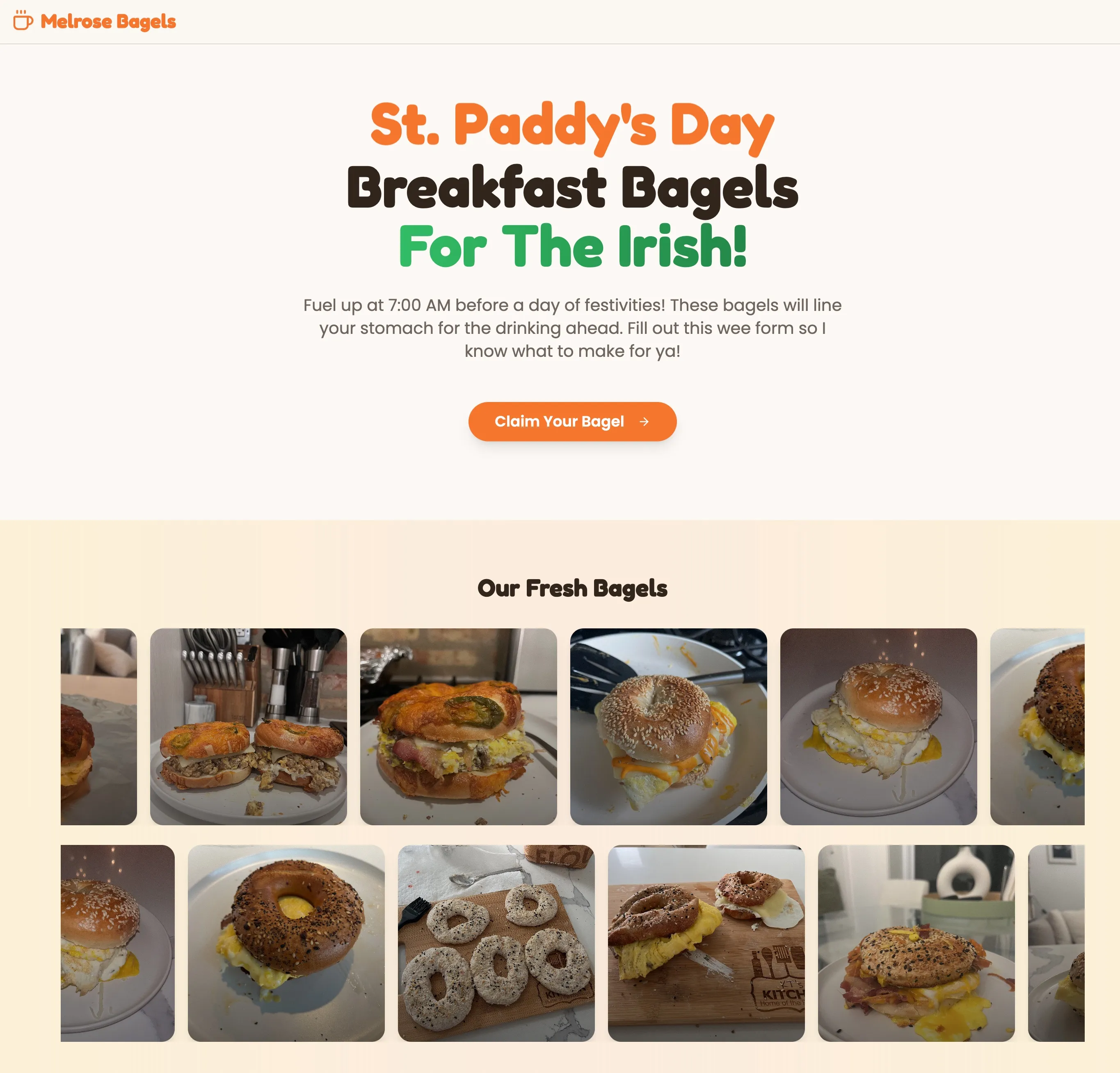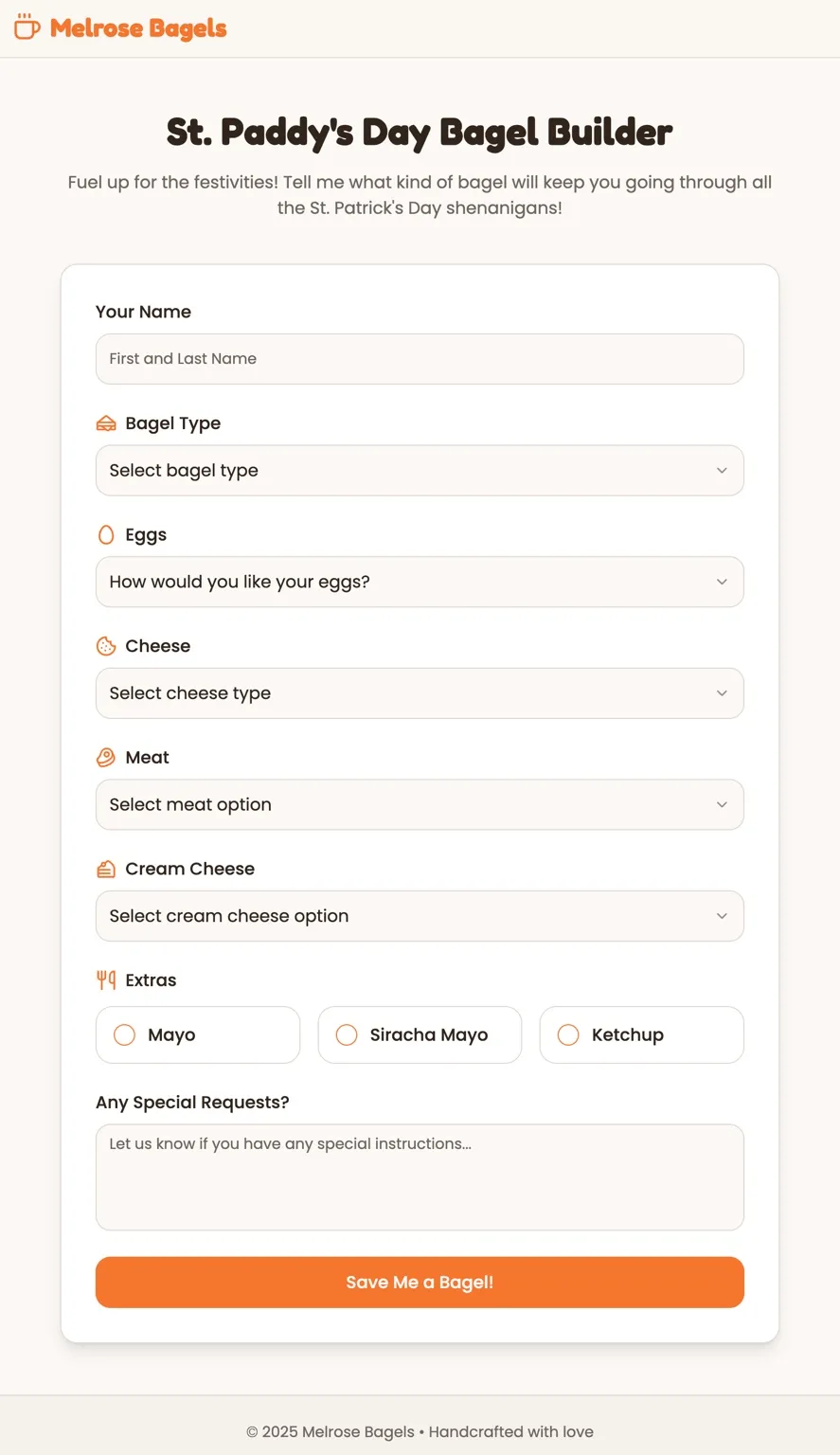On-demand software
The year is 2025. We're hosting some of Katie's (my girlfriend's) friends on Saturday morning at 7am before the long, extravagant St. Patrick's Day festivities in Chicago. Getting a proper breakfast in early is a must on days where the next meal is uncertain, the drinks flow faster than common sense, and the lines of conversations blur between brilliance and complete absurdity.
Now, it’s hard to find someone who doesn’t love a good bagel, and I happen to love making them. Making food for the people I care about is one of the ways I express my love for them, something I most certainly inherited from my dad.
But here’s the thing: There are eight guests, each likely with their unique bagel preferences. While I'm strongly opinionated about what makes the perfect bagel (more egg than you’ll find at a shop, everything bagel slightly under toasted, cheddar cheese - melted, with the meat craving of the day, if you’re curious), who am I to assume everyone's tastes align with mine? What about our guests? How do they love their bagel like I love mine? Plain? Jalapeño cheddar? Chive or no chive? Wait, is any of them gluten free? Only way to know is to ask. So why not take orders?
But remember—this isn’t 2023. This is 2025.
Traditionally what could’ve been a sloppy text chain or a generic Google Form is now something much more exciting - today, we’re living in the future. In 2025, we can create a responsive, well-designed, personalized website just to capture our friends’ bagel orders for this fun, little one-off St. Patrick’s day breakfast. It’ll get everyone excited about the morning, the forthcoming delicious warm bagel, and make them feel special by getting their own personalized order. Not some generic form made for millions of use cases and used by millions of people, but a single-purpose website for this exact moment. A single website, made for a single occasion, made by a single person: me. It was essentially made on-demand, for us (in 45 minutes, nonetheless — check it out here).
Yes, there are easier ways to make breakfast for your guests. A Google Form could certainly have done the job just fine! But it wouldn't have been as special or as meaningful, no matter if it was merely a smidge moreso.
And I think that's fun. That in and of itself—being able to conjure up software for what could've been the most mundane of interactions—is special. And it's where software is going.
Not all of it. But some of it. I think it may have been Jordan Singer who first coined this term “on-demand software"; the idea that the ability to create software is becoming exponentially more accessible. It’s since been marketed a multitude of ways, most notably by Replit: “whatever you need… make an app for that” [ad].
What might take 45 minutes for an experienced AI Product Manager (whatever you call my skillset) today could probably take a 5-year-old 5 minutes in 2 years. This is the worst it will ever be and the longest on-demand software will ever take. Imagine being able to just dream up a product to solve one of your everyday Wednesday afternoon problems and then actually having it built on the fly. For any occasion or desire. Event planning? Gaming? Search? Organization? The possibilities? Endless.
But just because everyone can, not everyone will. And not everyone that does can produce at the same level. Take cooking for example. My girlfriend has access to the same set of kitchen tools that I do—yet she has the intuition, creativity, and experience to cook meals to a quality that I wouldn't even be able to come up with if you gave me an hour and the internet to prep for it. These ideas simply pop into her head on a walk.
There are three levels to the "everyone can cook" analogy:
- Knowing what tools are out there
- Knowing how to best use the tools that are out there
- Knowing how to use the best tools better than others
If you're reading this, you likely have what would in the past be considered a restaurant-quality kitchen with the food and tools available to you just down the hall. And chances are, you've also enjoyed ordering food from an on-demand delivery service.
Who's to say exactly where this concept of on-demand software will go, but it certainly isn’t about replacing professional software development or the products we love and use daily. It's about democratizing the ability to create purpose-built digital experiences for moments that matter to you. It's about bringing the same level of personalization to software that we expect from other aspects of our lives.
There’s nothing special about that little bagel order website to the rest of the world. It won’t even change it for the internet stranger that might happen to come across it. But for that Saturday morning in March 2025, it’ll make breakfast feel a little more special for eight people nursing pre-St. Patrick’s Day hangovers. Isn't that exactly what technology should do? Make our human moments more meaningful, even in small ways.

